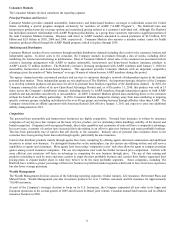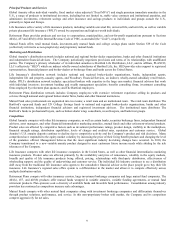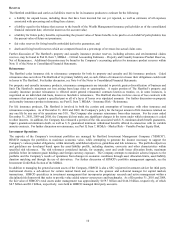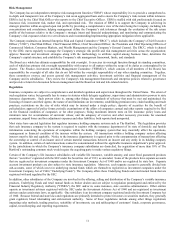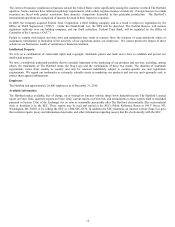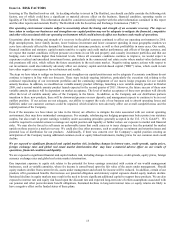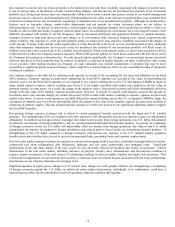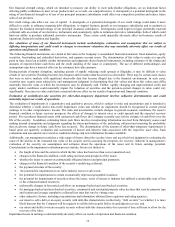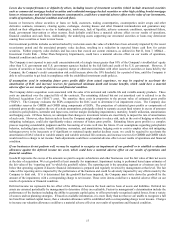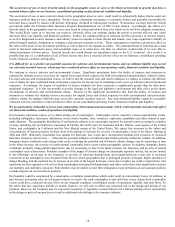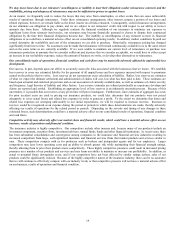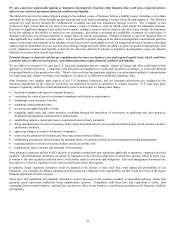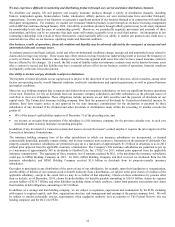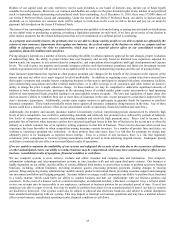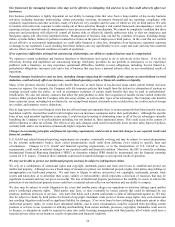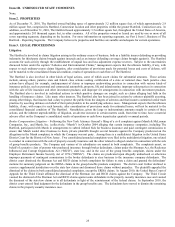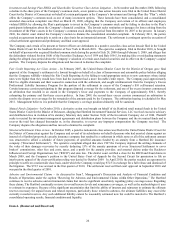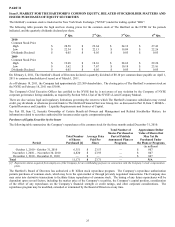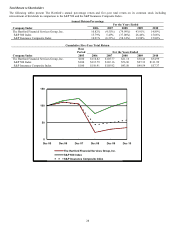The Hartford 2010 Annual Report Download - page 18
Download and view the complete annual report
Please find page 18 of the 2010 The Hartford annual report below. You can navigate through the pages in the report by either clicking on the pages listed below, or by using the keyword search tool below to find specific information within the annual report. 18
The occurrence of one or more terrorist attacks in the geographic areas we serve or the threat of terrorism in general may have a
material adverse effect on our business, consolidated operating results, financial condition and liquidity.
The occurrence of one or more terrorist attacks in the geographic areas we serve could result in substantially higher claims under our
insurance policies than we have anticipated. Private sector catastrophe reinsurance is extremely limited and generally unavailable for
terrorism losses caused by attacks with nuclear, biological, chemical or radiological weapons. Reinsurance coverage from the federal
government under the Terrorism Risk Insurance Program Reauthorization Act of 2007 is also limited. Accordingly, the effects of a
terrorist attack in the geographic areas we serve may result in claims and related losses for which we do not have adequate reinsurance.
This would likely cause us to increase our reserves, adversely affect our earnings during the period or periods affected and, could
adversely affect our liquidity and financial condition. Further, the continued threat of terrorism and the occurrence of terrorist attacks,
as well as heightened security measures and military action in response to these threats and attacks, may cause significant volatility in
global financial markets, disruptions to commerce and reduced economic activity. These consequences could have an adverse effect on
the value of the assets in our investment portfolio as well as those in our separate accounts. The continued threat of terrorism also could
result in increased reinsurance prices and potentially cause us to retain more risk than we otherwise would retain if we were able to
obtain reinsurance at lower prices. Terrorist attacks also could disrupt our operations centers in the U.S. or abroad. As a result, it is
possible that any, or a combination of all, of these factors may have a material adverse effect on our business, consolidated operating
results, financial condition and liquidity.
It is difficult for us to predict our potential exposure for asbestos and environmental claims, and our ultimate liability may exceed
our currently recorded reserves, which may have a material adverse effect on our operating results, financial condition and liquidity.
We continue to receive asbestos and environmental claims. Significant uncertainty limits the ability of insurers and reinsurers to
estimate the ultimate reserves necessary for unpaid losses and related expenses for both environmental and particularly asbestos claims.
For some asbestos and environmental claims, we believe that the actuarial tools and other techniques we employ to estimate the ultimate
cost of claims for more traditional kinds of insurance exposure are less precise in estimating reserves for our asbestos and environmental
exposures. Accordingly, the degree of variability of reserve estimates for these exposures is significantly greater than for other more
traditional exposures. It is also not possible to predict changes in the legal and legislative environment and their effect on the future
development of asbestos and environmental claims. Because of the significant uncertainties that limit the ability of insurers and
reinsurers to estimate the ultimate reserves necessary for unpaid losses and related expenses for both environmental and particularly
asbestos claims, the ultimate liabilities may exceed the currently recorded reserves. Any such additional liability cannot be reasonably
estimated now but could have a material adverse effect on our consolidated operating results, financial condition and liquidity.
We are particularly vulnerable to losses from catastrophes, both natural and man-made, which could materially and adversely affect
our financial condition, results of operations and liquidity.
Our insurance operations expose us to claims arising out of catastrophes. Catastrophes can be caused by various unpredictable events,
including earthquakes, hurricanes, hailstorms, severe winter weather, fires, tornadoes, explosions, pandemics and other natural or man-
made disasters. The geographic distribution of our business subjects us to catastrophe exposure for natural events occurring in a number
of areas, including, but not limited to, hurricanes in Florida, the Gulf Coast, the Northeast and the Atlantic coast regions of the United
States, and earthquakes in California and the New Madrid region of the United States. We expect that increases in the values and
concentrations of insured property in these areas will continue to increase the severity of catastrophic events in the future. Starting in
2004 and 2005, third-party catastrophe loss models for hurricane loss events have incorporated medium-term forecasts of increased
hurricane frequency and severity — reflecting the potential influence of multi-decadal climate patterns within the Atlantic. In addition,
changing climate conditions across longer time scales, including the potential risk of broader climate change, may be increasing, or may
in the future increase, the severity of certain natural catastrophe losses across various geographic regions. In addition, changing climate
conditions, primarily rising global temperatures, may be increasing, or may in the future increase, the frequency and severity of natural
catastrophes such as hurricanes. Potential examples of the impact of climate change on catastrophe exposure include, but are not limited
to the following: an increase in the frequency or severity of wind and thunderstorm and tornado/hailstorm events due to increased
convection in the atmosphere, more frequent brush fires in certain geographies due to prolonged periods of drought, higher incidence of
deluge flooding, and the potential for an increase in severity of the largest hurricane events due to higher sea surface temperatures. Our
operations are also exposed to risk of loss from catastrophes associated with pandemics and other events that could significantly increase
our mortality and morbidity exposures. Policyholders may be unable to meet their obligations to pay premiums on our insurance policies
or make deposits on our investment products.
Our liquidity could be constrained by a catastrophe, or multiple catastrophes, which could result in extraordinary losses. In addition, in
part because accounting rules do not permit insurers to reserve for such catastrophic events until they occur, claims from catastrophic
events could have a material adverse effect on our financial condition, consolidated results of operations, liquidity and cash flows. To
the extent that loss experience unfolds or models improve, we will seek to reflect any increased risk in the design and pricing of our
products. However, the Company may be exposed to regulatory or legislative actions that prevent a full accounting of loss expectations
in the design or price of our products or result in additional risk-shifting to the insurance industry.


